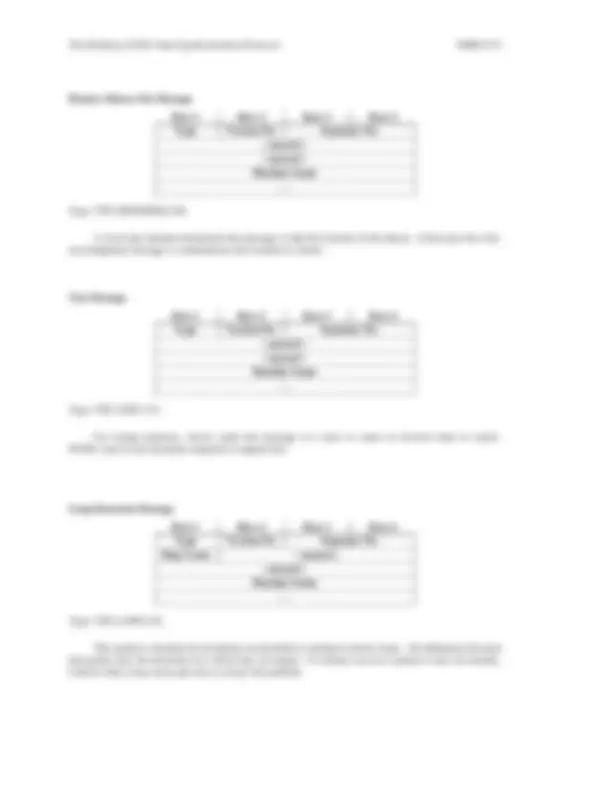








Study with the several resources on Docsity

Earn points by helping other students or get them with a premium plan


Prepare for your exams
Study with the several resources on Docsity

Earn points to download
Earn points by helping other students or get them with a premium plan
Community
Ask the community for help and clear up your study doubts
Discover the best universities in your country according to Docsity users
Free resources
Download our free guides on studying techniques, anxiety management strategies, and thesis advice from Docsity tutors
Introduction. The Time Synchronization Protocol (TSP) has been designed for specific use by the program timed, a local area network clock synchronizer for ...
Typology: Exercises
1 / 10

This page cannot be seen from the preview
Don't miss anything!







Riccardo Gusella, Stefano Zatti, and James M. Bloom
Computer Systems Research Group
Computer Science Division
Department of Electrical Engineering and Computer Science
University of California, Berkeley
Berkeley, CA 94720
Introduction
The Time Synchronization Protocol (TSP) has been designed for specific use by the program timed , a
local area network clock synchronizer for the UNIX 4.3BSD operating system. Timed is built on the
DARPA UDP protocol [4] and is based on a master slave scheme.
TSP serves a dual purpose. First, it supports messages for the synchronization of the clocks of the
various hosts in a local area network. Second, it supports messages for the election that occurs among
slave time daemons when, for any reason, the master disappears. The synchronization mechanism and the
election procedure employed by the program timed are described in other documents [1,2,3].
Briefly, the synchronization software, which works in a local area network, consists of a collection of
time daemons (one per machine) and is based on a master-slave structure. The present implementation
keeps processor clocks synchronized within 20 milliseconds. A master time daemon measures the time
difference between the clock of the machine on which it is running and those of all other machines. The
current implementation uses ICMP Time Stamp Requests [5] to measure the clock difference between
machines. The master computes the network time as the average of the times provided by nonfaulty
clocks.
1 It then sends to each slave time daemon the correction that should be performed on the clock of its
machine. This process is repeated periodically. Since the correction is expressed as a time difference
rather than an absolute time, transmission delays do not interfere with synchronization. When a machine
comes up and joins the network, it starts a slave time daemon, which will ask the master for the correct
time and will reset the machine’s clock before any user activity can begin. The time daemons therefore
maintain a single network time in spite of the drift of clocks away from each other.
Additionally, a time daemon on gateway machines may run as a submaster. A submaster time dae-
mon functions as a slave on one network that already has a master and as master on other networks. In
addition, a submaster is responsible for propagating broadcast packets from one network to the other.
To ensure that service provided is continuous and reliable, it is necessary to implement an election
algorithm that will elect a new master should the machine running the current master crash, the master ter-
minate (for example, because of a run-time error), or the network be partitioned. Under our algorithm,
slaves are able to realize when the master has stopped functioning and to elect a new master from among
themselves. It is important to note that since the failure of the master results only in a gradual divergence
hhhhhhhhhhhhhhhhhh
† UNIX is a trademark of Bell Laboratories.
This work was sponsored by the Defense Advanced Research Projects Agency (DoD), monitored by the Naval Electronics
Systems Command under contract No. N00039-84-C-0089, and by the Italian CSELT Corporation. The views and conclu-
sions contained in this document are those of the authors and should not be interpreted as representing official policies, ei-
ther expressed or implied, of the Defense Research Projects Agency, of the US Government, or of CSELT.
1 A clock is considered to be faulty when its value is more than a small specified interval apart from the majority of the
clocks of the machines on the same network. See [1,2] for more details.
SMM:22-2 The Berkeley UNIX Time Synchronization Protocol
of clock values, the election need not occur immediately.
All the communication occurring among time daemons uses the TSP protocol. While some mes-
sages need not be sent in a reliable way, most communication in TSP requires reliability not provided by
the underlying protocol. Reliability is achieved by the use of acknowledgements, sequence numbers, and
retransmission when message losses occur. When a message that requires acknowledgment is not ack-
nowledged after multiple attempts, the time daemon that has sent the message will assume that the addres-
see is down. This document will not describe the details of how reliability is implemented, but will only
point out when a message type requires a reliable transport mechanism.
The message format in TSP is the same for all message types; however, in some instances, one or
more fields are not used. The next section describes the message format. The following sections describe
in detail the different message types, their use and the contents of each field. NOTE: The message format
is likely to change in future versions of timed.
Message Format
All fields are based upon 8-bit bytes. Fields should be sent in network byte order if they are more
than one byte long. The structure of a TSP message is the following:
A one byte message type.
A one byte version number, specifying the protocol version which the message uses.
A two byte sequence number to be used for recognizing duplicate messages that occur when mes-
sages are retransmitted.
or may be unused depending on the type of the packet.
message.
The following charts describe the message types, show their fields, and explain their usages. For the
purpose of the following discussion, a time daemon can be considered to be in one of three states: slave,
master, or candidate for election to master. Also, the term broadcast refers to the sending of a message to
all active time daemons.
Adjtime Message
Byte 1 Byte 2 Byte 3 c
c Byte 4 iiiiiiiiiiiiiiiiiiiiiiiiiiiiiiiiiiiiiiiiiiiiiiiiiiii iiiiiiiiiiiiiiiiiiiiiiiiiiiiiiiiiiiiiiiiiiiiiiiiiiii
Type c
c
c
Version No. c
c
c
Sequence No. iiiiiiiiiiiiiiiiiiiiiiiiiiiiiiiiiiiiiiiiiiiiiiiiiiii
Seconds of Adjustment iiiiiiiiiiiiiiiiiiiiiiiiiiiiiiiiiiiiiiiiiiiiiiiiiiii
Microseconds of Adjustment iiiiiiiiiiiiiiiiiiiiiiiiiiiiiiiiiiiiiiiiiiiiiiiiiiii
Machine Name iiiiiiiiiiiiiiiiiiiiiiiiiiiiiiiiiiiiiiiiiiiiiiiiiiii
iiiiiiiiiiiiiiiiiiiiiiiiiiiiiiiiiiiiiiiiiiiiiiiiiiiic c
c
c
c
c
c
cc
c
c
c
c
c
c
Type: TSP_ADJTIME (1)
The master sends this message to a slave to communicate the difference between the clock of the
slave and the network time the master has just computed. The slave will accordingly adjust the time of its
machine. This message requires an acknowledgment.
SMM:22-4 The Berkeley UNIX Time Synchronization Protocol
Set Network Time Message
Byte 1 Byte 2 Byte 3 c
c Byte 4 iiiiiiiiiiiiiiiiiiiiiiiiiiiiiiiiiiiiiiiiiiiiiiiiiiii iiiiiiiiiiiiiiiiiiiiiiiiiiiiiiiiiiiiiiiiiiiiiiiiiiii
Type c
c
c
Version No. c
c
c
Sequence No. iiiiiiiiiiiiiiiiiiiiiiiiiiiiiiiiiiiiiiiiiiiiiiiiiiii
Seconds of Time to Set iiiiiiiiiiiiiiiiiiiiiiiiiiiiiiiiiiiiiiiiiiiiiiiiiiii
Microseconds of Time to Set iiiiiiiiiiiiiiiiiiiiiiiiiiiiiiiiiiiiiiiiiiiiiiiiiiii
Machine Name iiiiiiiiiiiiiiiiiiiiiiiiiiiiiiiiiiiiiiiiiiiiiiiiiiii
iiiiiiiiiiiiiiiiiiiiiiiiiiiiiiiiiiiiiiiiiiiiiiiiiiiic c
c
c
c
c
c
cc
c
c
c
c
c
c
Type: TSP_SETTIME (5)
The master sends this message to slave time daemons to set their time. This packet is sent to newly
started time daemons and when the network date is changed. It contains the master’s time as an approxi-
mation of the network time. It requires an acknowledgment. The next synchronization round will elim-
inate the small time difference caused by the random delay in the communication channel.
Master Active Message
Byte 1 Byte 2 Byte 3 c
c Byte 4 iiiiiiiiiiiiiiiiiiiiiiiiiiiiiiiiiiiiiiiiiiiiiiiiiiii iiiiiiiiiiiiiiiiiiiiiiiiiiiiiiiiiiiiiiiiiiiiiiiiiiii
Type c
c
c
Version No. c
c
c
Sequence No. iiiiiiiiiiiiiiiiiiiiiiiiiiiiiiiiiiiiiiiiiiiiiiiiiiii
( unused ) iiiiiiiiiiiiiiiiiiiiiiiiiiiiiiiiiiiiiiiiiiiiiiiiiiii
( unused ) iiiiiiiiiiiiiiiiiiiiiiiiiiiiiiiiiiiiiiiiiiiiiiiiiiii
Machine Name iiiiiiiiiiiiiiiiiiiiiiiiiiiiiiiiiiiiiiiiiiiiiiiiiiii
iiiiiiiiiiiiiiiiiiiiiiiiiiiiiiiiiiiiiiiiiiiiiiiiiiiic c
c
c
c
c
c
cc
c
c
c
c
c
c
Type: TSP_MASTERUP (6)
The master broadcasts this message to solicit the names of the active slaves. Slaves will reply with a
Slave Active message.
Slave Active Message
Byte 1 Byte 2 Byte 3 c
c Byte 4 iiiiiiiiiiiiiiiiiiiiiiiiiiiiiiiiiiiiiiiiiiiiiiiiiiii iiiiiiiiiiiiiiiiiiiiiiiiiiiiiiiiiiiiiiiiiiiiiiiiiiii
Type c
c
c
Version No. c
c
c
Sequence No. iiiiiiiiiiiiiiiiiiiiiiiiiiiiiiiiiiiiiiiiiiiiiiiiiiii
( unused ) iiiiiiiiiiiiiiiiiiiiiiiiiiiiiiiiiiiiiiiiiiiiiiiiiiii
( unused ) iiiiiiiiiiiiiiiiiiiiiiiiiiiiiiiiiiiiiiiiiiiiiiiiiiii
Machine Name iiiiiiiiiiiiiiiiiiiiiiiiiiiiiiiiiiiiiiiiiiiiiiiiiiii
iiiiiiiiiiiiiiiiiiiiiiiiiiiiiiiiiiiiiiiiiiiiiiiiiiiic c
c
c
c
c
c
cc
c
c
c
c
c
c
Type: TSP_SLAVEUP (7)
A slave sends this message to the master in answer to a Master Active message. This message is also
sent when a new slave starts up to inform the master that it wants to be synchronized.
The Berkeley UNIX Time Synchronization Protocol SMM:22-
Master Candidature Message
Byte 1 Byte 2 Byte 3 c
c Byte 4 iiiiiiiiiiiiiiiiiiiiiiiiiiiiiiiiiiiiiiiiiiiiiiiiiiii iiiiiiiiiiiiiiiiiiiiiiiiiiiiiiiiiiiiiiiiiiiiiiiiiiii
Type c
c
c
Version No. c
c
c
Sequence No. iiiiiiiiiiiiiiiiiiiiiiiiiiiiiiiiiiiiiiiiiiiiiiiiiiii
( unused ) iiiiiiiiiiiiiiiiiiiiiiiiiiiiiiiiiiiiiiiiiiiiiiiiiiii
( unused ) iiiiiiiiiiiiiiiiiiiiiiiiiiiiiiiiiiiiiiiiiiiiiiiiiiii
Machine Name iiiiiiiiiiiiiiiiiiiiiiiiiiiiiiiiiiiiiiiiiiiiiiiiiiii
iiiiiiiiiiiiiiiiiiiiiiiiiiiiiiiiiiiiiiiiiiiiiiiiiiiic c
c
c
c
c
c
cc
c
c
c
c
c
c
Type: TSP_ELECTION (8)
A slave eligible to become a master broadcasts this message when its election timer expires. The
message declares that the slave wishes to become the new master.
Candidature Acceptance Message
Byte 1 Byte 2 Byte 3 c
c Byte 4 iiiiiiiiiiiiiiiiiiiiiiiiiiiiiiiiiiiiiiiiiiiiiiiiiiii iiiiiiiiiiiiiiiiiiiiiiiiiiiiiiiiiiiiiiiiiiiiiiiiiiii
Type c
c
c
Version No. c
c
c
Sequence No. iiiiiiiiiiiiiiiiiiiiiiiiiiiiiiiiiiiiiiiiiiiiiiiiiiii
( unused ) iiiiiiiiiiiiiiiiiiiiiiiiiiiiiiiiiiiiiiiiiiiiiiiiiiii
( unused ) iiiiiiiiiiiiiiiiiiiiiiiiiiiiiiiiiiiiiiiiiiiiiiiiiiii
Machine Name iiiiiiiiiiiiiiiiiiiiiiiiiiiiiiiiiiiiiiiiiiiiiiiiiiii
iiiiiiiiiiiiiiiiiiiiiiiiiiiiiiiiiiiiiiiiiiiiiiiiiiiic c
c
c
c
c
c
cc
c
c
c
c
c
c
Type: TSP_ACCEPT (9)
A slave sends this message to accept the candidature of the time daemon that has broadcast an Elec-
tion message. The candidate will add the slave’s name to the list of machines that it will control should it
become the master.
Candidature Rejection Message
Byte 1 Byte 2 Byte 3 c
c Byte 4 iiiiiiiiiiiiiiiiiiiiiiiiiiiiiiiiiiiiiiiiiiiiiiiiiiii iiiiiiiiiiiiiiiiiiiiiiiiiiiiiiiiiiiiiiiiiiiiiiiiiiii
Type c
c
c
Version No. c
c
c
Sequence No. iiiiiiiiiiiiiiiiiiiiiiiiiiiiiiiiiiiiiiiiiiiiiiiiiiii
( unused ) iiiiiiiiiiiiiiiiiiiiiiiiiiiiiiiiiiiiiiiiiiiiiiiiiiii
( unused ) iiiiiiiiiiiiiiiiiiiiiiiiiiiiiiiiiiiiiiiiiiiiiiiiiiii
Machine Name iiiiiiiiiiiiiiiiiiiiiiiiiiiiiiiiiiiiiiiiiiiiiiiiiiii
iiiiiiiiiiiiiiiiiiiiiiiiiiiiiiiiiiiiiiiiiiiiiiiiiiiic c
c
c
c
c
c
cc
c
c
c
c
c
c
Type: TSP_REFUSE (10)
After a slave accepts the candidature of a time daemon, it will reply to any election messages from
other slaves with this message. This rejects any candidature other than the first received.
The Berkeley UNIX Time Synchronization Protocol SMM:22-
Set Date Message
Byte 1 Byte 2 Byte 3 c
c Byte 4 iiiiiiiiiiiiiiiiiiiiiiiiiiiiiiiiiiiiiiiiiiiiiiiiiiii iiiiiiiiiiiiiiiiiiiiiiiiiiiiiiiiiiiiiiiiiiiiiiiiiiii
Type c
c
c
Version No. c
c
c
Sequence No. iiiiiiiiiiiiiiiiiiiiiiiiiiiiiiiiiiiiiiiiiiiiiiiiiiii
Seconds of Time to Set iiiiiiiiiiiiiiiiiiiiiiiiiiiiiiiiiiiiiiiiiiiiiiiiiiii
Microseconds of Time to Set iiiiiiiiiiiiiiiiiiiiiiiiiiiiiiiiiiiiiiiiiiiiiiiiiiii
Machine Name iiiiiiiiiiiiiiiiiiiiiiiiiiiiiiiiiiiiiiiiiiiiiiiiiiii
iiiiiiiiiiiiiiiiiiiiiiiiiiiiiiiiiiiiiiiiiiiiiiiiiiiic c
c
c
c
c
c
cc
c
c
c
c
c
c
Type: TSP_SETDATE (22)
The program date (1) sends this message to the local time daemon when a super-user wants to set the
network date. If the local time daemon is the master, it will set the date; if it is a slave, it will communicate
the desired date to the master.
Set Date Request Message
Byte 1 Byte 2 Byte 3 c
c Byte 4 iiiiiiiiiiiiiiiiiiiiiiiiiiiiiiiiiiiiiiiiiiiiiiiiiiii iiiiiiiiiiiiiiiiiiiiiiiiiiiiiiiiiiiiiiiiiiiiiiiiiiii
Type c
c
c
Version No. c
c
c
Sequence No. iiiiiiiiiiiiiiiiiiiiiiiiiiiiiiiiiiiiiiiiiiiiiiiiiiii
Seconds of Time to Set iiiiiiiiiiiiiiiiiiiiiiiiiiiiiiiiiiiiiiiiiiiiiiiiiiii
Microseconds of Time to Set iiiiiiiiiiiiiiiiiiiiiiiiiiiiiiiiiiiiiiiiiiiiiiiiiiii
Machine Name iiiiiiiiiiiiiiiiiiiiiiiiiiiiiiiiiiiiiiiiiiiiiiiiiiii
iiiiiiiiiiiiiiiiiiiiiiiiiiiiiiiiiiiiiiiiiiiiiiiiiiiic c
c
c
c
c
c
cc
c
c
c
c
c
c
Type: TSP_SETDATEREQ (23)
A slave that has received a Set Date message will communicate the desired date to the master using
this message.
Set Date Acknowledgment Message
Byte 1 Byte 2 Byte 3 c
c Byte 4 iiiiiiiiiiiiiiiiiiiiiiiiiiiiiiiiiiiiiiiiiiiiiiiiiiii iiiiiiiiiiiiiiiiiiiiiiiiiiiiiiiiiiiiiiiiiiiiiiiiiiii
Type c
c
c
Version No. c
c
c
Sequence No. iiiiiiiiiiiiiiiiiiiiiiiiiiiiiiiiiiiiiiiiiiiiiiiiiiii
( unused ) iiiiiiiiiiiiiiiiiiiiiiiiiiiiiiiiiiiiiiiiiiiiiiiiiiii
( unused ) iiiiiiiiiiiiiiiiiiiiiiiiiiiiiiiiiiiiiiiiiiiiiiiiiiii
Machine Name iiiiiiiiiiiiiiiiiiiiiiiiiiiiiiiiiiiiiiiiiiiiiiiiiiii
iiiiiiiiiiiiiiiiiiiiiiiiiiiiiiiiiiiiiiiiiiiiiiiiiiiic c
c
c
c
c
c
cc
c
c
c
c
c
c
Type: TSP_DATEACK (16)
The master sends this message to a slave in acknowledgment of a Set Date Request Message. The
same message is sent by the local time daemon to the program date(1) to confirm that the network date has
been set by the master.
SMM:22-8 The Berkeley UNIX Time Synchronization Protocol
Start Tracing Message
Byte 1 Byte 2 Byte 3 c
c Byte 4 iiiiiiiiiiiiiiiiiiiiiiiiiiiiiiiiiiiiiiiiiiiiiiiiiiii iiiiiiiiiiiiiiiiiiiiiiiiiiiiiiiiiiiiiiiiiiiiiiiiiiii
Type c
c
c
Version No. c
c
c
Sequence No. iiiiiiiiiiiiiiiiiiiiiiiiiiiiiiiiiiiiiiiiiiiiiiiiiiii
( unused ) iiiiiiiiiiiiiiiiiiiiiiiiiiiiiiiiiiiiiiiiiiiiiiiiiiii
( unused ) iiiiiiiiiiiiiiiiiiiiiiiiiiiiiiiiiiiiiiiiiiiiiiiiiiii
Machine Name iiiiiiiiiiiiiiiiiiiiiiiiiiiiiiiiiiiiiiiiiiiiiiiiiiii
iiiiiiiiiiiiiiiiiiiiiiiiiiiiiiiiiiiiiiiiiiiiiiiiiiiic c
c
c
c
c
c
cc
c
c
c
c
c
c
Type: TSP_TRACEON (17)
The controlling program timedc sends this message to the local time daemon to start the recording in
a system file of all messages received.
Stop Tracing Message
Byte 1 Byte 2 Byte 3 c
c Byte 4 iiiiiiiiiiiiiiiiiiiiiiiiiiiiiiiiiiiiiiiiiiiiiiiiiiii iiiiiiiiiiiiiiiiiiiiiiiiiiiiiiiiiiiiiiiiiiiiiiiiiiii
Type c
c
c
Version No. c
c
c
Sequence No. iiiiiiiiiiiiiiiiiiiiiiiiiiiiiiiiiiiiiiiiiiiiiiiiiiii
( unused ) iiiiiiiiiiiiiiiiiiiiiiiiiiiiiiiiiiiiiiiiiiiiiiiiiiii
( unused ) iiiiiiiiiiiiiiiiiiiiiiiiiiiiiiiiiiiiiiiiiiiiiiiiiiii
Machine Name iiiiiiiiiiiiiiiiiiiiiiiiiiiiiiiiiiiiiiiiiiiiiiiiiiii
iiiiiiiiiiiiiiiiiiiiiiiiiiiiiiiiiiiiiiiiiiiiiiiiiiiic c
c
c
c
c
c
cc
c
c
c
c
c
c
Type: TSP_TRACEOFF (18)
Timedc sends this message to the local time daemon to stop the recording of messages received.
Master Site Message
Byte 1 Byte 2 Byte 3 c
c Byte 4 iiiiiiiiiiiiiiiiiiiiiiiiiiiiiiiiiiiiiiiiiiiiiiiiiiii iiiiiiiiiiiiiiiiiiiiiiiiiiiiiiiiiiiiiiiiiiiiiiiiiiii
Type c
c
c
Version No. c
c
c
Sequence No. iiiiiiiiiiiiiiiiiiiiiiiiiiiiiiiiiiiiiiiiiiiiiiiiiiii
( unused ) iiiiiiiiiiiiiiiiiiiiiiiiiiiiiiiiiiiiiiiiiiiiiiiiiiii
( unused ) iiiiiiiiiiiiiiiiiiiiiiiiiiiiiiiiiiiiiiiiiiiiiiiiiiii
Machine Name iiiiiiiiiiiiiiiiiiiiiiiiiiiiiiiiiiiiiiiiiiiiiiiiiiii
iiiiiiiiiiiiiiiiiiiiiiiiiiiiiiiiiiiiiiiiiiiiiiiiiiiic c
c
c
c
c
c
cc
c
c
c
c
c
c
Type: TSP_MSITE (19)
Timedc sends this message to the local time daemon to find out where the master is running.
SMM:22-10 The Berkeley UNIX Time Synchronization Protocol
References
USENIX Summer Conference Proceedings, Salt Lake City, June 1984.
Berkeley, Technical Report, to appear.
University of California, Berkeley, CS Technical Report #275, Dec. 1985.
Menlo Park, California, August 1980.
tional, Menlo Park, California, September 1981.